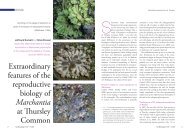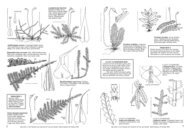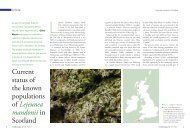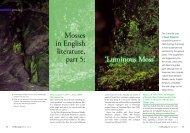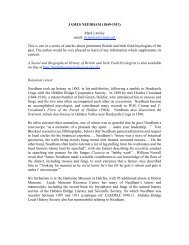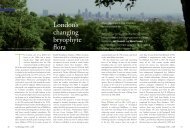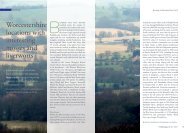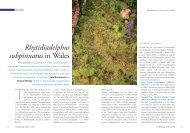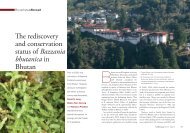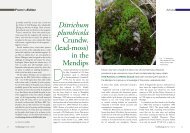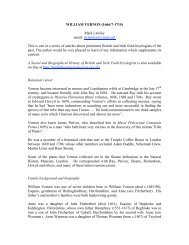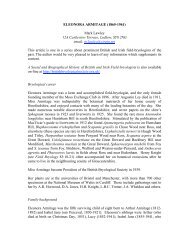Bryological Monograph An annotated checklist of the mosses of ...
Bryological Monograph An annotated checklist of the mosses of ...
Bryological Monograph An annotated checklist of the mosses of ...
Create successful ePaper yourself
Turn your PDF publications into a flip-book with our unique Google optimized e-Paper software.
ANNOTATIONS<br />
1. Ignatov & Afonina (1992) report Sphagnum imbricatum<br />
Hornsch. ex Russow (section Sphagnum), S.<br />
orientale L.I.Savicz (section Subsecunda) and S.<br />
perfoliatum L.I.Savicz (section Subsecunda) from<br />
arctic European Russia. The record <strong>of</strong> S. imbricatum<br />
would, if correct, be likely to refer to S. steerei<br />
R.E.<strong>An</strong>drus, which is seemingly <strong>the</strong> only taxon <strong>of</strong> <strong>the</strong><br />
S. imbricatum complex collected in arctic areas <strong>of</strong><br />
North America and Eurasia (Flatberg, 1984), and<br />
which is listed by Dierssen (2001). However, Afonina<br />
(pers. comm. to Flatberg) tells us that <strong>the</strong>re are no<br />
reliable herbarium specimens <strong>of</strong> European material <strong>of</strong><br />
any <strong>of</strong> <strong>the</strong>se species. They are <strong>the</strong>refore omitted.<br />
2. Sphagnum viride is closely related to S. cuspidatum<br />
(Flatberg, 1988), and isoenzymatic results indicate<br />
that gene flow exists between <strong>the</strong> two morphs<br />
(Hanssen, Sa˚stad & Flatberg, 2000). More genetic<br />
data are required to evaluate <strong>the</strong>ir taxonomic status.<br />
3. Sphagnum brevifolium and S. isoviitae belong to a<br />
small group <strong>of</strong> closely related taxa in <strong>the</strong> S. recurvum<br />
complex with yellow spores (Flatberg, 1992, 1992<br />
[1993]). In typical morphological appearance <strong>the</strong>y are<br />
well separated from S. fallax, but seem not clearly<br />
segregated genetically in sympatric populations<br />
(Sa˚stad, Stenøien & Flatberg, 1999). Their species<br />
status can <strong>the</strong>refore be questioned, and more genetic<br />
data are required before a decisive taxonomic conclusion<br />
can be drawn.<br />
4. The name Sphagnum lenense was published as a<br />
nomen nudum in 1915, and was not validated until<br />
1936 (Afonina and Egorova, pers. comm. to Flatberg).<br />
5. Sphagnum auriculatum is retained here as <strong>the</strong> name for<br />
<strong>the</strong> taxon that has, following a paper by Dirkse &<br />
Isoviita (1986), been called S. denticulatum in recent<br />
lists. Sphagnum denticulatum is an aquatic form with<br />
abnormally large, nearly isophyllous leaves. Although<br />
most such plants belong to S. auriculatum, similar<br />
forms <strong>of</strong> S. inundatum are found not uncommonly<br />
growing under aquatic conditions in mire pools along<br />
<strong>the</strong> western coast <strong>of</strong> Norway. The type specimen <strong>of</strong> S.<br />
denticulatum is <strong>the</strong>refore unsatisfactory.<br />
6. Sphagnum tundrae was described from Svalbard by<br />
Flatberg (1994).<br />
7. Sphagnum wulfianum is ei<strong>the</strong>r nested within section<br />
Acutifolia (Shaw, 2000b) or is sister to section<br />
Acutifolia, lying between it and section Squarrosa<br />
(Shaw, Cox & Boles, 2005). It is left here in its own<br />
section Polyclada.<br />
8. Sphagnum aongstroemii may be nested within section<br />
Acutifolia (Shaw, 2000b, Shaw et al., 2005). It is left<br />
here in its own section Insulosa.<br />
9. Sphagnum nitidulum Warnst. was described from<br />
Terceira in <strong>the</strong> Azores, but type material has<br />
presumably been destroyed and its identity is obscure.<br />
MOSSES OF EUROPE AND MACARONESIA 227<br />
10. Sphagnum subtile (Russow) Warnst. (S. capillifolium<br />
var. subtile (Russow) Kartt., S. rubellum var. subtile<br />
(Russow) Amann) is a disputed taxon whose distinctness<br />
can be questioned. Natcheva & Cronberg (2002)<br />
consider European herbarium material studied to<br />
belong to S. rubellum. Shaw et al. (2005) claim that<br />
North American plants named S. subtile cannot be<br />
separated genetically from S. capillifolium. The name<br />
is based on European material, but original material<br />
has not been traced. It is premature to disregard <strong>the</strong><br />
existence <strong>of</strong> a European taxon underlying this name.<br />
11. Sphagnum tenerum Sull. & Lesq. ex Sull. (S. capillifolium<br />
var. tenerum (Sull. & Lesq. ex Sull.) H.A.Crum)<br />
is an eastern North American species, which according<br />
to Shaw et al. (2005) is highly differentiated genetically<br />
from S. capillifolium. European plants labelled S.<br />
tenerum have been examined by Flatberg, and belong<br />
to hemi-isophyllous forms <strong>of</strong> S. capillifolium.<br />
12. Sphagnum olafii was described from Svalbard by<br />
Flatberg (1993a).<br />
13. Sphagnum rubiginosum was described from Norway by<br />
Flatberg (1993b).<br />
14. Sphagnum andersonianum has been reported from<br />
Europe, but Shaw et al. (2005) claim that examined<br />
material from Europe and North America cannot be<br />
distinguished by genetic markers from S. rubellum.<br />
15. Sections <strong>of</strong> <strong>An</strong>dreaea follow Murray (1988).<br />
16. Sérgio (2004) recognized <strong>An</strong>dreaea heinemannii subsp.<br />
crassifolia, stating that it does not intergrade morphologically<br />
with subsp. heinemannii and that <strong>the</strong>y are<br />
found in one mixed population. The taxon may thus<br />
merit species status.<br />
17. Smith (2004) treated <strong>the</strong> East Asian Atrichum rhystophyllum<br />
(Müll.Hal.) Paris as a synonym <strong>of</strong> A.<br />
angustatum, following Richards & Wallace (1950),<br />
who treated it as a variety <strong>of</strong> A. angustatum. The<br />
relationships <strong>of</strong> North American, European and East<br />
Asian representatives <strong>of</strong> this complex and <strong>the</strong>ir<br />
affinity with A. undulatum are not clear and are in<br />
need <strong>of</strong> thorough revision, as stated by Lou &<br />
Koponen (1986).<br />
18. A critical, global revision is required to clarify <strong>the</strong><br />
status <strong>of</strong> Atrichum flavisetum and its relationship to A.<br />
undulatum.<br />
19. Pogonatum inflexum (Lindb.) Sande Lac. is listed for<br />
Turkey by Kürschner & Erdag˘ (2005). Pogonatum<br />
inflexum is an exclusively East Asian species confined<br />
to China, Japan, Korea and <strong>the</strong> Russian Far East.<br />
Several records from o<strong>the</strong>r parts <strong>of</strong> mainland Asia<br />
have been confirmed as misidentified, and are mostly<br />
P. neesii (Hyvönen, 1989). We have not studied any<br />
Turkish material but are inclined to assume that <strong>the</strong>se<br />
records also represent P. neesii, a widespread Asian<br />
species with a disjunct occurrence in <strong>the</strong> Caucasus<br />
area (see below).<br />
20. According to Schratz (1928), Pogonatum aloides var.<br />
minimum (Crome) Molendo and P. nanum var. long-



